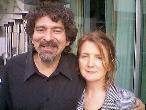| SOUNDTRACK SCREENPLAY DOWNLOADS SCREENINGS DVD |  |
|
|
 |
 |
 |
 |
 |
 |
|
||||||
|
Mexico The Critic The Rivera Murals The Casa Azul Jet-lag Festival Screening The Trotsky Museum Exile Profound Mexico Hope Rain on canvas The Jury The Anthropological Museum Time Political Correctness Two Houses False Virtue Life is a miracle Weird Roots The Meeting Turtles Can Fly The Oscars Luis Barragans house Back to Diary Index |
Profound Mexico At a buffet lunch on the windy rooftop of a seemingly deserted hotel, I meet some of the organizers of the festival. It seems to be run, mainly, by gorgeous young women; Ximena Hiriart, who I had first met at Telluride; the director of the festival, Paula Riestra; and a team of others, all of whom are charming, helpful and knowledgeable. I wish that I had the time to see other films in the festival – a John Cassavetes retrospective; films by Emile de Antonio, the North American radical; and documentaries which include a Chinese, eight-hour, hand-held, one man-crew epic (which eventually wins the best documentary prize). I also meet with Ramon Vera Herrera, friend and translator of John Berger’s work, and editor of a section of ‘La Jornada’, the daily Mexican newspaper. It turns out Ramon’s was one of the voices correcting the translation in my telephone press conference. We talk animatedly about John, about cinema, and about politics. Ramon describes how people in the indigenous liberation movement organize themselves. They are essentially anarchist, he explains, and believe in self government. They have a motto: “to govern is to obey”. A general assembly of the people is the highest authority. He talks of how in the 1840’s half of the territory of Mexico was ‘given’ to the USA . The border between the two countries used to be much higher; California , Utah , Texas , Colorado and Arizona were part of Mexico . Los Angeles is still thought of as the second city of Mexico ; there are ten million Mexicans living there. But why did they give it away, I ask, baffled. It is a question I continue to ask in the coming days and never quite manage to understand the answers, because of course it was not given, but taken, in war. But the conversation helps me to feel the power of the ongoing issues connected with the border. Ramon continues to talk about what he calls ‘profound Mexico ’ (the indigenous history) and how it seeps in hidden ways into the culture. Maize is the most important crop in Mexico and forms the basis of Mexican cuisine. Indigenous people see it as a generous crop. “We are the relations of maize”, they say; “we learn from maize how to live together in harmony”. This is because maize grows well in conjunction with pumpkins, beans and other essential crops. They also believe that self-government is impossible if you don’t grow your own food; a culture must be self-sustaining to retain its integrity and autonomy. For this reason the main conflict in Mexico now, Ramon explains, is between the transnational companies and the indigenous people. The war is for land; the transnationals want the people as cheap labour. There are also serious disputes arising from contamination of crops from transgenics. Monsanto ‘owns’ the patent of seeds they have developed, which drift on the wind and cross-fertilize with other crops. Ramon sees his role as editor of the magazine (whose name translates roughly as ‘popular civilization’) as being a companion, or mirror to, indigenous people; not leading, but following; simply helping to give back self-respect and dignity, honoring traditions and wisdom which have been systematically eroded. He says many of the indigenous leaders are very well-read. They know and admire John Berger’s work for example, which is heartening. back next |
 SP with Ramon Herrera  SP with Ximena and Paula |
||||
Text © Sally Potter. All pictures © Adventure Pictures unless otherwise indicated |